Modular line arrays used in pro-sound have some form of horizontal directivity control built into each box. Much too big and expensive for home use though.
Have not seen (via Googling) anyone trying a smaller version of this concept. Seems a line array could be done by integrating a 2-way source like a Unity horn. Or JBL RBI (radiation boundary integration) could be used for a waveguide.
As an aside, the directivity plots for the JBL Control67 (using RBI) appear smooth and hold pattern better than a smallish waveguide like the PT-F95HF. Looks comparable to the much larger PT-H95HF. Presumably has lower coloration due to direct radiator vs. horn/waveguide. (Yes, I do realize current waveguides are much better than the old "horn honk", but everything is a tradeoff and even the Geddes OS has foam to address coloration in a well-designed horn).
Anyone heard an RBI sytem? Concerned there would be cavity/plate resonance or other colorations. Has anyone seen what the RBI foam/plate looks like when disassembled? Any photos available? Realize it is patented, but like the Unity horn, it should be OK to DIY.
First thoughts on a specific implementation would be a stack of Vifa BC25SC55 (can the frame be removed like the D26NC55?). Flanked by MCM 55-3870s. ZA14W08s look good, but at obviously higher cost. A stack of BG Neo8s would be possible as tweeters too. Do not want an array with full range drivers, since do not think any are competitive in distortion, smoothness, etc. as well-proven dome tweeters.
Using a Unity technique, seems only a single LF column might be possible. Makes using nicer drivers affordable. Is driving the horn symmetrically necessary for the midranges in a Unity horn? Have not looked into Hornresp in detail, but seems it should be possible to simulate this?
With RBI, it seems the low-frequency horizontal directivity is just the result of physical driver size, so 2 LF columns would be needed MTM style.
More advanced would be to curve the array and apply shading, like the PE CBT36. Would be really, really hard to fabricate though.
Trying to put the Unity mid-entry as close to the tweeter as possible, a top view of this approach is shown below. Even that has a crazy amount of odd angles.
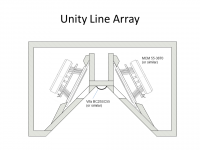
First-time post here, so any thoughts from this group on this concept welcome. Pointers to other resources or links would be much appreciated.
Thanks, Glen
Have not seen (via Googling) anyone trying a smaller version of this concept. Seems a line array could be done by integrating a 2-way source like a Unity horn. Or JBL RBI (radiation boundary integration) could be used for a waveguide.
As an aside, the directivity plots for the JBL Control67 (using RBI) appear smooth and hold pattern better than a smallish waveguide like the PT-F95HF. Looks comparable to the much larger PT-H95HF. Presumably has lower coloration due to direct radiator vs. horn/waveguide. (Yes, I do realize current waveguides are much better than the old "horn honk", but everything is a tradeoff and even the Geddes OS has foam to address coloration in a well-designed horn).
Anyone heard an RBI sytem? Concerned there would be cavity/plate resonance or other colorations. Has anyone seen what the RBI foam/plate looks like when disassembled? Any photos available? Realize it is patented, but like the Unity horn, it should be OK to DIY.
First thoughts on a specific implementation would be a stack of Vifa BC25SC55 (can the frame be removed like the D26NC55?). Flanked by MCM 55-3870s. ZA14W08s look good, but at obviously higher cost. A stack of BG Neo8s would be possible as tweeters too. Do not want an array with full range drivers, since do not think any are competitive in distortion, smoothness, etc. as well-proven dome tweeters.
Using a Unity technique, seems only a single LF column might be possible. Makes using nicer drivers affordable. Is driving the horn symmetrically necessary for the midranges in a Unity horn? Have not looked into Hornresp in detail, but seems it should be possible to simulate this?
With RBI, it seems the low-frequency horizontal directivity is just the result of physical driver size, so 2 LF columns would be needed MTM style.
More advanced would be to curve the array and apply shading, like the PE CBT36. Would be really, really hard to fabricate though.
Trying to put the Unity mid-entry as close to the tweeter as possible, a top view of this approach is shown below. Even that has a crazy amount of odd angles.

First-time post here, so any thoughts from this group on this concept welcome. Pointers to other resources or links would be much appreciated.
Thanks, Glen
Modular line arrays used in pro-sound have some form of horizontal directivity control built into each box. Much too big and expensive for home use though.
Have not seen (via Googling) anyone trying a smaller version of this concept. Seems a line array could be done by integrating a 2-way source like a Unity horn. Or JBL RBI (radiation boundary integration) could be used for a waveguide.
As an aside, the directivity plots for the JBL Control67 (using RBI) appear smooth and hold pattern better than a smallish waveguide like the PT-F95HF. Looks comparable to the much larger PT-H95HF. Presumably has lower coloration due to direct radiator vs. horn/waveguide. (Yes, I do realize current waveguides are much better than the old "horn honk", but everything is a tradeoff and even the Geddes OS has foam to address coloration in a well-designed horn).
Anyone heard an RBI sytem? Concerned there would be cavity/plate resonance or other colorations. Has anyone seen what the RBI foam/plate looks like when disassembled? Any photos available? Realize it is patented, but like the Unity horn, it should be OK to DIY.
First thoughts on a specific implementation would be a stack of Vifa BC25SC55 (can the frame be removed like the D26NC55?). Flanked by MCM 55-3870s. ZA14W08s look good, but at obviously higher cost. A stack of BG Neo8s would be possible as tweeters too. Do not want an array with full range drivers, since do not think any are competitive in distortion, smoothness, etc. as well-proven dome tweeters.
Using a Unity technique, seems only a single LF column might be possible. Makes using nicer drivers affordable. Is driving the horn symmetrically necessary for the midranges in a Unity horn? Have not looked into Hornresp in detail, but seems it should be possible to simulate this?
With RBI, it seems the low-frequency horizontal directivity is just the result of physical driver size, so 2 LF columns would be needed MTM style.
More advanced would be to curve the array and apply shading, like the PE CBT36. Would be really, really hard to fabricate though.
Trying to put the Unity mid-entry as close to the tweeter as possible, a top view of this approach is shown below. Even that has a crazy amount of odd angles.
View attachment 295830
First-time post here, so any thoughts from this group on this concept welcome. Pointers to other resources or links would be much appreciated.
Thanks, Glen
As soon as I saw the JBL RBI, the first thought that I had was that "JBL discovered the Unity horn:"
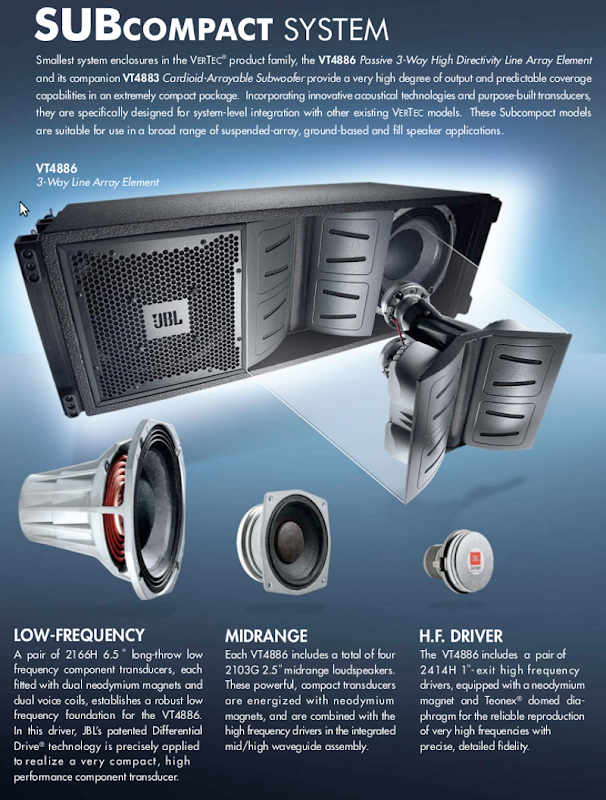
http://www.diyaudio.com/forums/multi-way/207440-jbls-take-unity-horn.html
I have not heard a JBL RBI, or the Control 67. I *do* own a pile of "Control Nows", which I bought when Costco was doing them for $99 each. As I see it, there isn't a better speaker for under $300 or so. The Control Now has a lot in common with Keele's CBT. If you play around with the geometry using the line array spreadsheet from FRD consortium, you'll likely notice that there are a lot of advantages to a curved array.
I've been messing around with Paralines a lot lately:
http://www.diyaudio.com/forums/multi-way/217298-square-pegs.html
I think they solve a lot of problems for projects like this.
Here's some reasons you should consider a Paraline instead of a dome tweeter:
- A Paraline gives you a wavefront that's a good match for an array. I would argue that the main reason that the Control Now and the CBT work better curved is that a curved array reduces interaction between the tweeter array. Basically the CBT gets the tweeters so close together that the array of them behave like one long tall skinny driver. The Paraline yields a long skinny wavefront also, but the Paraline also reduces driver excursion, raises efficiency, and allows the use of compression drivers with a sensitivity of 109dB, instead of dome tweeters with an efficiency of 81dB. Theoretically a single compression driver is more sensitive than the entire array of tweeters in a CBT.
- Paralines are ridiculously easy to build. I could teach a ten year old how to build a Paraline. No weird angles, no complex jigs, just super super easy.
- I haven't tried a Paraline with multiple compression drivers, but it *seems* that would be very do-able. While it may seem like total overkill to use four or eight compression drivers for a home stereo project, I'd argue that there are a lot of good reasons to do it. Lower xover point, big dynamics, potentially more even coverage in the room, etc. I'm pretty close to trying a dual-Paraline array myself, with a total of four compression drivers and sixteen(!) midranges for a stereo pair.
Hope that helps!
I think you're on to some good ideas here, good to see others exploring them.
Oh -
Forgot to mention.
If you want a curved array a la the Keele CBT, but you also want Unity Summation a la The Unity Horn, there's nothing stopping you from curving a Paraline.
Just build it out of plywood, then bend the plywood into your desired shape.
Also, this would also look incredibly trick!
Can you imagine what your friends would say when they hear music emanating from a sheet of plywood with no drivers in it?! (In the Paraline the drivers are buried inside, and can't be seen at all.)
Forgot to mention.
If you want a curved array a la the Keele CBT, but you also want Unity Summation a la The Unity Horn, there's nothing stopping you from curving a Paraline.
An externally hosted image should be here but it was not working when we last tested it.
Just build it out of plywood, then bend the plywood into your desired shape.
Also, this would also look incredibly trick!
Can you imagine what your friends would say when they hear music emanating from a sheet of plywood with no drivers in it?! (In the Paraline the drivers are buried inside, and can't be seen at all.)
Glen, it's an interesting idea. Do keep in mind that the location of the ports and the volume under the cone are important parameters.
If doing this with a dome tweeter, then consider a ring radiator.
BG Neo tweeters also worth considering.
You can get line array compression drivers, but I'd want to hear them first. I have my suspicions they would not be the best sounding option.
It's not a bad idea with a project like this to build a single pair to test your idea. Ideally you'd want to measure it outdoors on an elevated turntable, at 10 degree increments out to 90 degrees. Active makes it simpler, and also increases your chances at getting your chosen tweeter to work down low enough to cross to the mids. That's a critical issue.
If doing this with a dome tweeter, then consider a ring radiator.
BG Neo tweeters also worth considering.
You can get line array compression drivers, but I'd want to hear them first. I have my suspicions they would not be the best sounding option.
It's not a bad idea with a project like this to build a single pair to test your idea. Ideally you'd want to measure it outdoors on an elevated turntable, at 10 degree increments out to 90 degrees. Active makes it simpler, and also increases your chances at getting your chosen tweeter to work down low enough to cross to the mids. That's a critical issue.
Thanks Patrick, the Paraline idea is interesting. Looked through your Square Peg posts on this topic.
The VTC EL210 uses 2 compression drivers to cover about 14" of vertical space. What would be the limits of making the "eye" big, so a single driver could cover 20" or more? Then only a couple of drivers would be needed for a 40" tall array.
The published response of the Paraline does not look that smooth, though. Not sure about comparable smoothing, but it appears worse than what has been posted for compression drivers in PT or OS waveguides.
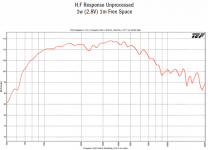
The main reason line arrays are of interest to me is that vertical directivity can be controlled with a small footprint. The JBL CBT 100LA is 40" tall and maintains 100 degree coverage at 300Hz. Assuming that measurement is free space, then the floor (and ceiling) mirror images would drive that lower. A conventional horn, Unity or otherwise, would have to be very large to do that. However, conventional line arrays, even the PE CBT36 do not control horizontal directivity.
A line array + horizontal waveguide could offer superior vertical coverage control, and horizontal control as good as conventional PT/OS waveguides (say ~100 degree coverage at 1.5KHz). And do that with reasonable floor area.
It does not seem that the JBL RBI is a "unity" concept. In the VT4886, the waveguide looks to be solely for the benefit of the HF driver, and the mids fire through the slots. The horizontal coverage for mid-low seems to correspond to the physical separation of the drivers, WMTMW.
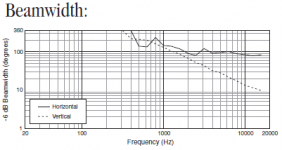
It is interesting that 2 compression drivers are summed in about 7" of vertical space. There appears to be a long narrow slot for summing, and wonder if that would introduce coloration like a diffraction horn.
Also just noticed that the Control 67 rolls off quite early for a dome tweeter, could it be that the RBI foam is absorbing some of the HF. OTOH, the VT4886 is impressively flat.
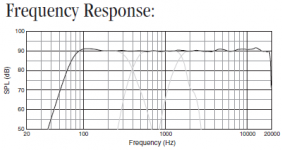
As an aside, expect that a curved array would be done in piece-wise linear sections just like a pro modular array. Straight sections of about 6-8" would be stacked with about 5-7 degrees tilt between sections.
The VTC EL210 uses 2 compression drivers to cover about 14" of vertical space. What would be the limits of making the "eye" big, so a single driver could cover 20" or more? Then only a couple of drivers would be needed for a 40" tall array.
The published response of the Paraline does not look that smooth, though. Not sure about comparable smoothing, but it appears worse than what has been posted for compression drivers in PT or OS waveguides.

The main reason line arrays are of interest to me is that vertical directivity can be controlled with a small footprint. The JBL CBT 100LA is 40" tall and maintains 100 degree coverage at 300Hz. Assuming that measurement is free space, then the floor (and ceiling) mirror images would drive that lower. A conventional horn, Unity or otherwise, would have to be very large to do that. However, conventional line arrays, even the PE CBT36 do not control horizontal directivity.
A line array + horizontal waveguide could offer superior vertical coverage control, and horizontal control as good as conventional PT/OS waveguides (say ~100 degree coverage at 1.5KHz). And do that with reasonable floor area.
It does not seem that the JBL RBI is a "unity" concept. In the VT4886, the waveguide looks to be solely for the benefit of the HF driver, and the mids fire through the slots. The horizontal coverage for mid-low seems to correspond to the physical separation of the drivers, WMTMW.

It is interesting that 2 compression drivers are summed in about 7" of vertical space. There appears to be a long narrow slot for summing, and wonder if that would introduce coloration like a diffraction horn.
Also just noticed that the Control 67 rolls off quite early for a dome tweeter, could it be that the RBI foam is absorbing some of the HF. OTOH, the VT4886 is impressively flat.

As an aside, expect that a curved array would be done in piece-wise linear sections just like a pro modular array. Straight sections of about 6-8" would be stacked with about 5-7 degrees tilt between sections.
- Status
- This old topic is closed. If you want to reopen this topic, contact a moderator using the "Report Post" button.